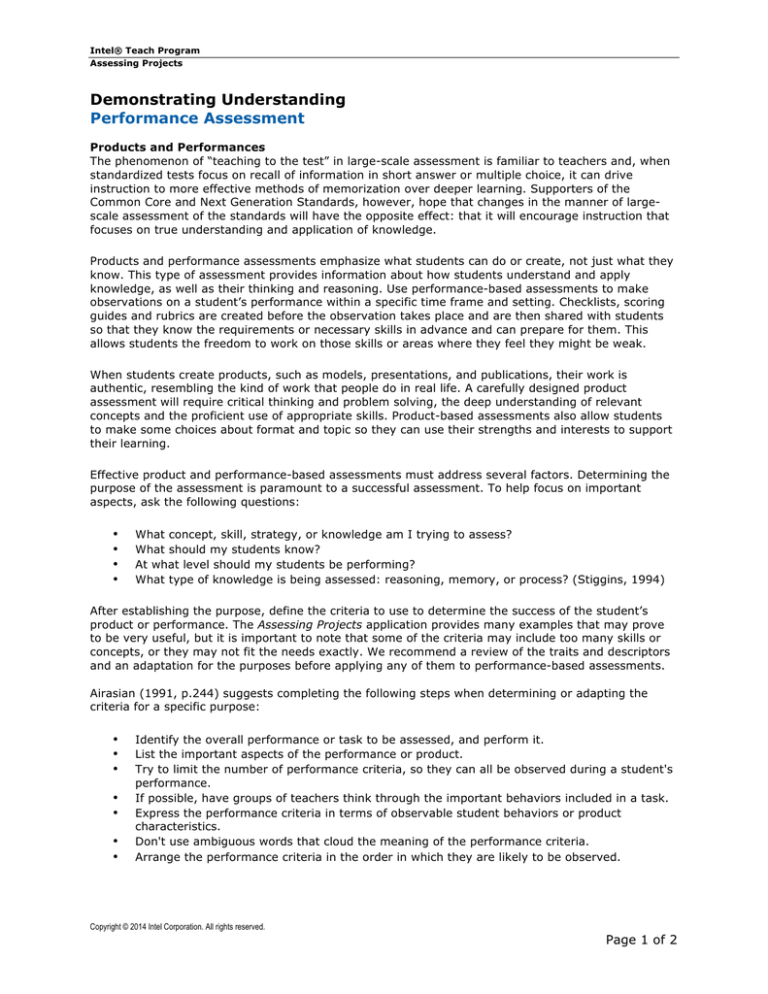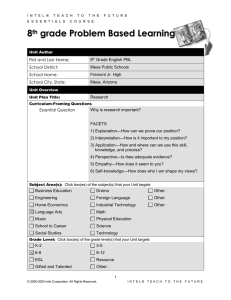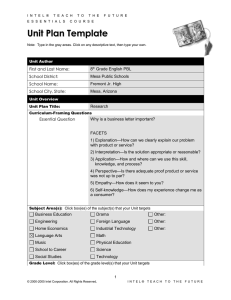
Intel® Teach Program
Assessing Projects
Demonstrating Understanding
Performance Assessment
Products and Performances
The phenomenon of “teaching to the test” in large-scale assessment is familiar to teachers and, when
standardized tests focus on recall of information in short answer or multiple choice, it can drive
instruction to more effective methods of memorization over deeper learning. Supporters of the
Common Core and Next Generation Standards, however, hope that changes in the manner of largescale assessment of the standards will have the opposite effect: that it will encourage instruction that
focuses on true understanding and application of knowledge.
Products and performance assessments emphasize what students can do or create, not just what they
know. This type of assessment provides information about how students understand and apply
knowledge, as well as their thinking and reasoning. Use performance-based assessments to make
observations on a student’s performance within a specific time frame and setting. Checklists, scoring
guides and rubrics are created before the observation takes place and are then shared with students
so that they know the requirements or necessary skills in advance and can prepare for them. This
allows students the freedom to work on those skills or areas where they feel they might be weak.
When students create products, such as models, presentations, and publications, their work is
authentic, resembling the kind of work that people do in real life. A carefully designed product
assessment will require critical thinking and problem solving, the deep understanding of relevant
concepts and the proficient use of appropriate skills. Product-based assessments also allow students
to make some choices about format and topic so they can use their strengths and interests to support
their learning.
Effective product and performance-based assessments must address several factors. Determining the
purpose of the assessment is paramount to a successful assessment. To help focus on important
aspects, ask the following questions:
•
•
•
•
What concept, skill, strategy, or knowledge am I trying to assess?
What should my students know?
At what level should my students be performing?
What type of knowledge is being assessed: reasoning, memory, or process? (Stiggins, 1994)
After establishing the purpose, define the criteria to use to determine the success of the student’s
product or performance. The Assessing Projects application provides many examples that may prove
to be very useful, but it is important to note that some of the criteria may include too many skills or
concepts, or they may not fit the needs exactly. We recommend a review of the traits and descriptors
and an adaptation for the purposes before applying any of them to performance-based assessments.
Airasian (1991, p.244) suggests completing the following steps when determining or adapting the
criteria for a specific purpose:
•
•
•
•
•
•
•
Identify the overall performance or task to be assessed, and perform it.
List the important aspects of the performance or product.
Try to limit the number of performance criteria, so they can all be observed during a student's
performance.
If possible, have groups of teachers think through the important behaviors included in a task.
Express the performance criteria in terms of observable student behaviors or product
characteristics.
Don't use ambiguous words that cloud the meaning of the performance criteria.
Arrange the performance criteria in the order in which they are likely to be observed.
Copyright © 2014 Intel Corporation. All rights reserved.
Page 1 of 2
Intel® Teach Program
Assessing Projects
Valuable information is gained about how to help students improve when utilizing these performancebased assessment strategies. Using the criteria determined in advance and observing the process as
well as the product, provides for a careful analysis of student performance as well as opportunities to
look for patterns related to teaching and learning goals. This allows for the modification or
development of instructional practices to facilitate growth among all students. When analyzing
collected data, questions to consider include:
•
Did successful students use a different approach than less successful students?
•
Were the less successful performers hindered by misconceptions and how might they have
developed these misconceptions?
Where in the process did students run into difficulty?
What kinds of errors did they make?
Are there certain traits that students have difficulty with?
Are there consistent misconceptions across the class that need addressing?
•
•
•
•
Copyright © 2014 Intel Corporation. All rights reserved. Intel, the Intel logo, the Intel Education Initiative, and the Intel Teach Program are trademarks of Intel Corporation or its
subsidiaries in the U.S. and other countries.
*Other names and brands may be claimed as the property of others.
Page 2 of 2




